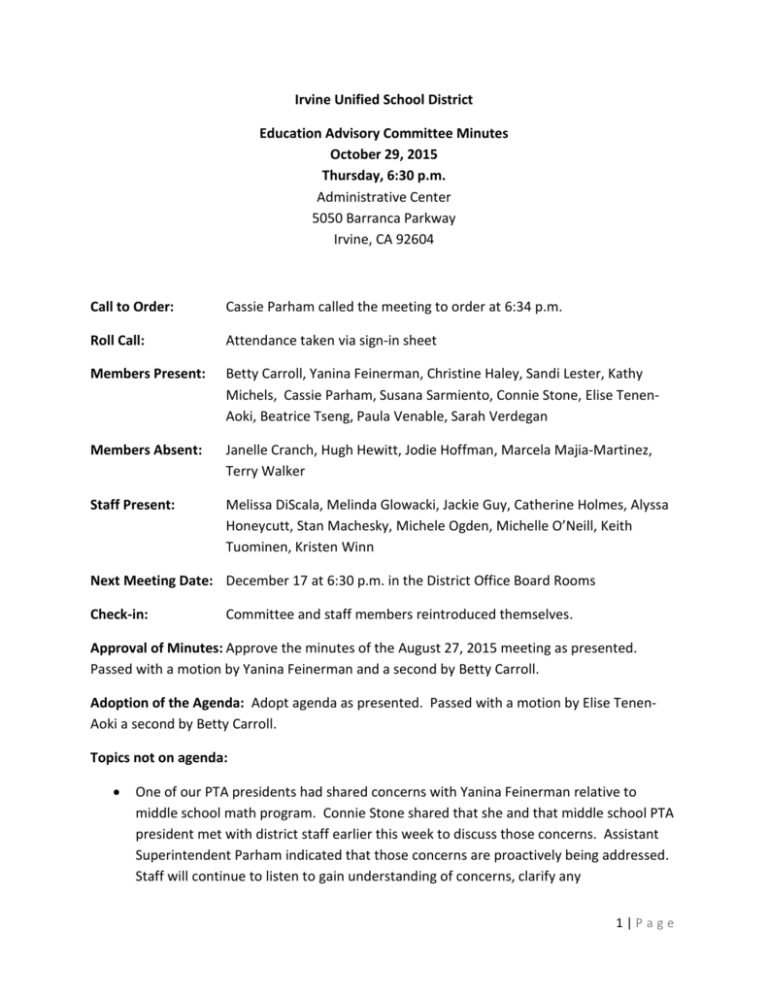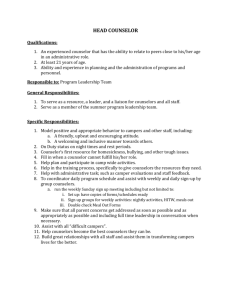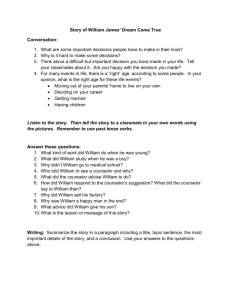Minutes - Irvine Unified School District
advertisement

Irvine Unified School District Education Advisory Committee Minutes October 29, 2015 Thursday, 6:30 p.m. Administrative Center 5050 Barranca Parkway Irvine, CA 92604 Call to Order: Cassie Parham called the meeting to order at 6:34 p.m. Roll Call: Attendance taken via sign-in sheet Members Present: Betty Carroll, Yanina Feinerman, Christine Haley, Sandi Lester, Kathy Michels, Cassie Parham, Susana Sarmiento, Connie Stone, Elise TenenAoki, Beatrice Tseng, Paula Venable, Sarah Verdegan Members Absent: Janelle Cranch, Hugh Hewitt, Jodie Hoffman, Marcela Majia-Martinez, Terry Walker Staff Present: Melissa DiScala, Melinda Glowacki, Jackie Guy, Catherine Holmes, Alyssa Honeycutt, Stan Machesky, Michele Ogden, Michelle O’Neill, Keith Tuominen, Kristen Winn Next Meeting Date: December 17 at 6:30 p.m. in the District Office Board Rooms Check-in: Committee and staff members reintroduced themselves. Approval of Minutes: Approve the minutes of the August 27, 2015 meeting as presented. Passed with a motion by Yanina Feinerman and a second by Betty Carroll. Adoption of the Agenda: Adopt agenda as presented. Passed with a motion by Elise TenenAoki a second by Betty Carroll. Topics not on agenda: One of our PTA presidents had shared concerns with Yanina Feinerman relative to middle school math program. Connie Stone shared that she and that middle school PTA president met with district staff earlier this week to discuss those concerns. Assistant Superintendent Parham indicated that those concerns are proactively being addressed. Staff will continue to listen to gain understanding of concerns, clarify any 1|Page misconceptions, and ensure that we’re providing appropriate supports. She also shared that concerns may differ from school to school so we need to ensure that we tailor supports to the needs of each particular schools, and that many schools don’t appear to be fielding concerns related math at this time. Keith Tuominen encouraged parents to talk with teachers and principals. Education Advisory Committee Business a. Education Advisory Committee Structure At the August 27 meeting, committee members asked that consideration be given to adopting a meeting structure congruent with the Finance Committee structure. Cassie Parham shared that the Finance Committee’s basic structure is similar to Education Advisory Committee structure. A difference being that the Board President’s appointed member serves as the Chair and reports back to the President following the meeting. A Former Finance Committee member, Kathy Michels, shared that John Fogarty facilitated the meetings rather than the Chair. After discussion, Board appointed committee members unanimously voted to retain current EAC meeting structure. Yes Betty Carroll Yes Yanina Feinerman Absent Hugh Hewitt Absent Jodie Hoffman Absent for vote Sandi Lester Absent Marcela Majia-Martinez Yes Kathy Michels Yes Elise Tenen-Aoki Yes Beatrice Tseng b. Creating Balanced Lives for Our Students Cassie disseminated an organizer for the presentation and asked committee members to identify / determine what they consider to be the most student compelling and serious stressors. She also asked the committee to consider, during the presentation, the programs, interventions, and various support systems that might target those stressors. Social-Emotional and Mental Health Supports for Students Michelle O’Neill Coordinator/Guidance Resources and Melissa DiScala, Coordinator/Mental Health and 504 Plans presented social-emotional health supports to help students cope with and lead a balanced life. Programs/ 2|Page opportunities supported by Guidance Resources and shared in the presentation include: Second Step Program This program has been implemented at every elementary school and provides social-emotional curriculum that covers learning about empathy, anger management skills, problem-solving and decision-making skills, bullying prevention, etc. Evidence-based curriculum builds with each subsequent year. Teachers can invite counselors to meet in small groups or with class as a whole. The question was asked, “How are students referred to small group?” Teacher referral or parent may contact teacher for assistance. Several committee members had not heard of Second Step program and are interested in making certain information is readily available to parents. Elementary Resource Counselors Staff anticipates 12 elementary resource counselors will be hired in December 2015. Counselors will provide individual and small group short-term counseling to students, assist in the development of positive behavior and improved attendance, provide support for Foster Youth and McKinney Vento students, etc. Project Success Offered to all middle and high school campuses. Goals of program are to increase resiliency, support students in healthy and safe lifestyle choices, decrease incidence of problem behaviors related to tobacco and drug use. Positive Behavior Interventions and Supports (PBIS) PBIS is a positive, preventative and proactive approach to establishing the behavioral supports and social culture needed for all students to achieve social, emotional and academic success. Cassie Parham shared that rather than being punitive, the program teaches students to do the right things. Students hold each other accountable. Paula Venable talked about how PBIS creates a positive school community and culture and involves everyone on campus. Catherine Holmes shared there is an emphasis on data… for instance where disruptive behaviors are occur, what time of day the behavior occurs, who is involved, etc. Staff examines what’s happening and can alter the environment. Sarah Verdegan: PBIS is well-known at the elementary and middle school levels where rewards/awards are more readily given and more subtle at the high 3|Page school level, because high school students need different approaches. Christine Haley also shared that PBIS works differently in high schools and students are recognized in different ways (i.e.) WHS honor warrior breakfast. Teachers nominate students based on theme. Anyone can be nominated; it’s not about academics. Cassie shared that WHS, UHS, and NHS are our last three schools to implement PBIS. Keith discussed that Irvine High has had PBIS in place for 10 plus years (our first high school to implement) and the tenets of PBIS are very evident on campus. Irvine Family Resource Center Therapists provide short-term, solution-focused counseling for K-12 students and families who may not have access to affordable mental health or family support services. Mental Health Interventions and Supports Wellness Counselors Clinically trained mental health specialists are at all high schools and support feeder middle and elementary schools in their region. Their primary focus is directed toward our most at risk high school students. Wellness counselors perform intake and link students to local resources. Counselors also participate on intervention teams. Our Wellness Counselors are new this year, and we will continue to assess how to define their roles most effectively to structure effective support. Schools are also finding interesting ways to provide additional support through their counseling teams. Yanina shared that WHS sponsors a counselor of the day program. Counselor sits in quad (or elsewhere) at lunch. Students can talk about anything from a serious problem to “Am I in the right math class?” Crisis Intervention Provides support and education re: suicide prevention including helping staff and students understand and look for signs of suicidal tendencies and how to support students. Crisis Response At times a school may need to respond to an event that affects a large portion of the student population. This can include psychological first aid, group counseling, and classroom check-ins to inform students of event and where they can get help. 4|Page Training for Teachers and School Staff Provides teacher training on mental health awareness, identification, and referral. Also provides training on suicide assessment and intervention and supporting students with mental health needs for school mental health staff. Additional Commentary Wellness Counselor: Connie expressed concern that a student would not take a social-emotional issue to an “academic” counselor because that is the person who will help them gain college admission. It was shared that high school counselors are not exclusively “academic” counselors; they are able to talk at many levels. Cassie also shared that four of our high schools (including Creekside) have advisement. The intention is to connect to an adult and develop a relationship. Our challenge is knowing when our students are struggling and the need to get them to open up and be candid. We can’t always help unless we know they need help. Resources for parents are impressive; PTAs are supporting mental wellness and helping to distribute and communicate information. Sandi Lester shared that intra-district conversations about mental wellness would be beneficial. Some schools may be further along than others. They can learn from each other. Keith indicated that most of the last week’s all counselor meeting was spent sharing practices. Sarah Verdegan indicated that students are required to meet with “academic” counselor before seeing a wellness counselor and that the Student/Counselor ratio is still high. Many students are stressed and not always sharing with parent, teacher or counselor. Pressure is serious problem (dinner, violin, SAT practice, etc.) Sarah suggested that passes be given for homework or tests. Closing Commentary: Because we have a second presentation, committee will carry over the topic of Creating Balanced Lives for students to next meeting. (Our second staff presentation will focus explicitly on school based wellness initiatives at the elementary, middle and high school level.) Adjournment: The meeting was adjourned at 8:43 p.m. on a motion made by Beatrice Tseng and seconded by Betty Carroll. 5|Page






